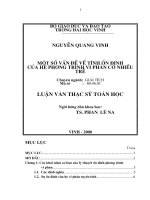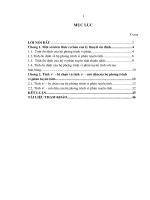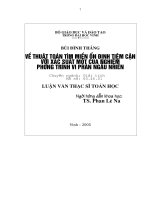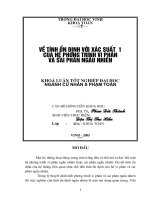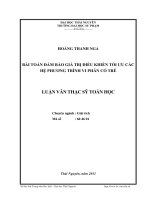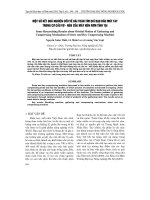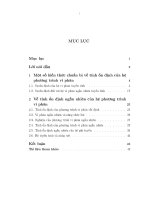MỘT VÀI KẾT QUẢ MỚI VỀ BÀI TOÁN ĐẢM BẢO CHI PHÍ ĐIỀU KHIỂN TRONG THỜI GIAN HỮU HẠN CỦA HỆ PHƯƠNG TRÌNH VI PHÂN TUYẾN TÍNH PHÂN THỨ PHÙ HỢP
Bạn đang xem bản rút gọn của tài liệu. Xem và tải ngay bản đầy đủ của tài liệu tại đây (287.98 KB, 7 trang )
<span class='text_page_counter'>(1)</span><div class='page_container' data-page=1>
<i>e-ISSN: 2615-9562 </i>
<b>NEW RESULTS ON FINITE-TIME GUARANTEED COST CONTROL OF </b>
<b>LINEAR UNCERTAIN CONFORMABLE FRACTIONAL-ORDER SYSTEMS </b>
<b>Nguyen Thi Phuong1*<sub>, Nguyen Tai Giap</sub>2</b>
<i>1<sub>TNU - University of Technology, </sub></i>
<i>2<sub>College of Statistics, Bac Ninh</sub></i>
ABSTRACT
In this paper, we investigate the problem of finite-time guaranteed cost control of linear uncertain
conformable fractional order systems. Firstly, a new cost function is defined. Then, by using some
properties of conformable fractional calculus, some new sufficient conditions for the design of a
state feedback controller that makes the closed-loop systems finite-time stable and guarantees an
adequate cost level of performance is derived via linear matrix inequalities, therefore can be
efficiently solved by using existing convex algorithms. A numerical example is given to illustrate
the effectiveness of the proposed method.
<i><b>Keyword: problem; finite-time guaranteed cost control; linear uncertain conformable fractional </b></i>
<i>order; systems; cost function. </i>
<i><b>Ngày nhận bài: 07/10/2019; Ngày hoàn thiện: 18/02/2020; Ngày đăng: 20/02/2020 </b></i>
<b>MỘT VÀI KẾT QUẢ MỚI VỀ BÀI TỐN ĐẢM BẢO CHI PHÍ ĐIỀU KHIỂN </b>
<b>TRONG THỜI GIAN HỮU HẠN CỦA HỆ PHƯƠNG TRÌNH </b>
<b>VI PHÂN TUYẾN TÍNH PHÂN THỨ PHÙ HỢP </b>
Nguyễn Thị Phương
<b>1*<sub>, Nguyễn Tài Giáp</sub>2</b><i>1<sub>Trường Đại học Kỹ thuật Công nghiệp - ĐH Thái Nguyên, </sub></i>
<i>2<sub> Trường Cao đẳng Thống kê, Bắc Ninh </sub></i>
TÓM TẮT
Trong bài báo này, chúng tơi nghiên cứu bài tốn đảm bảo chi phí điều khiển trong thời gian hữu
hạn của hệ phương trình vi phân tuyến tính phân thứ phù hợp. Trước hết, chúng tôi đưa ra một
định nghĩa về hàm chi phí. Sau đó, bằng cách sử dụng một số tính chất về giải tích phân thứ, một
điều kiện đủ cho việc thiết kế một điều khiển ngược tuyến tính đảm bảo cho hệ đóng tương ứng
khơng những ổn định hữu hạn thời gian mà còn đảm bảo hàm chi phí hữu hạn trong khoảng thời
gian đó. Các điều kiện nhận được đều dưới dạng các bất đẳng thức ma trận tuyến tính và có thể
giải số được một cách hiệu quả bằng các thuật toán lồi đã có. Một ví dụ số được đưa ra để minh
họa cho sự hiệu quả cho kết quả của chúng tơi.
<i><b>Từ khóa: bài tốn; đảm bảo chi phí điều khiển trong hữu hạn thời gian; hệ phương trình; vi phân </b></i>
<i>tuyến tính phân thứ phù hợp; hàm chi phí.</i>
<i><b>Received: 07/10/2019; Revised: 18/02/2020; Published: 20/02/2020 </b></i>
<i>* Corresponding author. Email: </i>
</div>
<span class='text_page_counter'>(2)</span><div class='page_container' data-page=2>
<b>1. Introduction </b>
Recently, a new definition of local fractional
(non-integer order) derivative which is called
the conformable fractional derivative was
introduced in [1]. Some well-behaved
properties of the conformable fractional
calculus such as chain rules, exponential
functions, Gronwall's inequality, fractional
integration by parts were derived in [2]. The
interest in the conformable derivative has
been increasing in the recent years because it
has numerous applications in science and
engineering. By using Lyapunov function, the
problems of stability and asymptotic stability
of conformable fractional-order nonlinear
systems were studied in [3]. Necessary and
sufficient conditions for the asymptotic
stability of the positive linear conformable
fractional-order systems were reported in [4].
On the other hand, from the view of
engineering, it is desirable to design a
controller such that the closed-loop system is
finite-time stable and an adequate level of
system performance is guaranteed. Some
interesting results on the problem of
finite-time guaranteed cost control for integer-order
systems were derived in [5, 6, 7, 8]. Although
there have been some works dedicated to
Lyapunov stability and finite-time stability of
conformable fractional-order systems, there
are no results on finite-time control of
uncertain conformable fractional-order
systems. The main aim of this paper is to fill
this gap.
In this paper, we present a novel approach to
solve the problem of finite-time guaranteed
cost control for linear uncertain conformable
fractional-order systems. Consequently, some
new explicit criteria for the problem are
derived via linear matrix inequalities, which
therefore can be efficiently solved by using
existing convex algorithms. A numerical
example is given to demonstrate of the
feasibility and the effectiveness of our
obtained results.
<b>Notations: The following notations will be </b>
used in this paper:<i><sub>¡ denotes the n - </sub>n</i>
dimensional linear real vector space with the
Euclidean norm . given by
2 2 2
1 2 ... <i>n</i>,
<i>x</i> = <i>x</i> +<i>x</i> + +<i>x</i> <i>x</i>=( ,<i>x x</i><sub>1</sub> <sub>2</sub>,...,<i>x<sub>n</sub></i>)<i>T</i>¡ . <i>n</i>
For a real matrix <i>A, </i> <sub>max</sub>( )<i>A</i> and
min( )<i>A</i>
denote the maximal and the minimal
<i>eigenvalue of A, respectively. </i>
<b>2. Preliminaries and Problem statement </b>
Firstly, we recall some definitions and
traditional results, which are essential in order
to derive our main results in this paper.
<i><b>Definition 2.1. ([1]) For any α (0; 1], the </b></i>
conformable fractional derivative
0 ( ( ))
<i>t</i>
<i>T</i> <i>f t</i> of
the function ( )<i>f t of order α is defined by </i>
0
1
0
0
( ( ) ) ( )
( ( )) lim
<i>t</i>
<i>f t</i> <i>t</i> <i>t</i> <i>f t</i>
<i>T</i> <i>f t</i>
−
→
+ − −
=
If <i>t = , then </i><sub>0</sub> 0
0( ( ))
<i>t</i>
<i>T</i> <i>f t</i> has the form
1
0
0
( ) ( )
( ( )) lim <i>f t</i> <i>t</i> <i>f t</i>
<i>T</i> <i>f t</i>
−
→
+ −
=
If the conformable fractional derivative <i>f t </i>( )
<i>of order α exists on </i> ( ,<i>t + , then the </i><sub>0</sub> )
function ( )<i>f t is said to be α-differentiable on </i>
the interval ( ,<i>t + . </i><sub>0</sub> )
<i><b>Deffinition 2.2. ([1]) Let α(0, 1]. The </b></i>
conformable fractional integral starting from
a point <i>t of a function </i><sub>0</sub> <i>f</i> :[ ,<i>t + → ¡ of </i><sub>0</sub> )
<i>order α is defined as </i>
0
0
1
0
( ( )) ( ) ( ) , 0
<i>t</i>
<i>t</i>
<i>t</i>
<i>I</i> <i>f t</i> =
<i>s</i>−<i>t</i> − <i>f s ds</i> <i>t</i>If <i>t = , then </i><sub>0</sub> 0
0( ( ))
<i>t</i>
<i>I</i> <i>f t</i> has the form
1
0
0
( ( )) ( ) , 0
<i>t</i>
<i>I</i> <i>f t</i> =
<i>s</i> − <i>f s ds</i> <i>t</i>In the case <i>t = , we will denote </i><sub>0</sub> 0
0( ( )) ( ( ))
<i>I</i> <i>f t</i> =<i>I</i> <i>f t</i>
<b>Lemma </b> <b>2.3. </b> ([2]) Let the function
0
:[ , )
</div>
<span class='text_page_counter'>(3)</span><div class='page_container' data-page=3>
1]. Then for all <i>t</i> we <i>t</i><sub>0</sub> have
0(T0 ( )) ( ) ( ).0
<i>t</i> <i>t</i>
<i>I</i> <i>f t</i> = <i>f t</i> − <i>f t</i>
<b>Lemma 2.4. ([3]) Let </b> <i>x t + → ¡ such </i>:[ ,<sub>0</sub> )
that
0 ( )
<i>t</i>
<i>T x t</i> exists on [ ,<i>t + and P is a </i><sub>0</sub> )
symmetric positive definite matrix. Then
0 ( ) ( )
<i>T</i>
<i>t</i>
<i>T x t Px t</i> exists on [ ,<i>t + </i><sub>0</sub> ) and
0 ( ) ( ) 2 ( ) 0 ( ), 0
<i>T</i> <i>T</i> <i>T</i>
<i>t</i> <i>t</i>
<i>T x t Px t</i> = <i>x t PT x t</i> . <i>t t</i>
Let us now consider the following uncertain
conformable fractional-order system:
0
( ) [ ( )] ( ) [ ( )] (t)
(1)
+[ ( )] ( )
(0)
<i>T x t</i> <i>A</i> <i>A t x t</i> <i>D</i> <i>D t</i>
<i>B</i> <i>B t u t</i>
<i>x</i> <i>x</i>
<sub></sub>
= + + +
<sub>+ </sub>
<sub>=</sub>
<i>where α (0, 1], </i> <i>x t ¡</i>( ) <i>n</i>is the state,
u( )<i>t ¡</i> <i>m</i>is the control, ( )<i>t</i> ¡ is the <i>p</i>
disturbance, <sub>0</sub> <i>n</i>
<i>x ¡</i> is the initial condition,
A, D, B are known real constant matrices of
appropriate dimensions. We make the
following assumptions throughout this paper:
(H1)<i>A t</i>( )=<i>E F t H<sub>a</sub></i> <i><sub>a</sub></i>( ) <i><sub>a</sub></i>,<i>D t</i>( )=<i>E F t H<sub>d</sub></i> <i><sub>d</sub></i>( ) <i><sub>d</sub></i>,
( ) <i><sub>b</sub></i> <i><sub>b</sub></i>( ) <i><sub>b</sub></i>
<i>B t</i> <i>E F t H</i>
=
where <i>E E E H H H are known real <sub>a</sub></i>, <i><sub>d</sub></i>, <i><sub>b</sub></i>, <i><sub>a</sub></i>, <i><sub>d</sub></i>, <i><sub>b</sub></i>
constant matrices of appropriate dimensions,
( ), ( ), ( )
<i>a</i> <i>d</i> <i>b</i>
<i>F t F t F t are unknown real </i>
time-varying matrices satisfying
( ) ( ) ,
<i>T</i>
<i>a</i> <i>a</i>
<i>F</i> <i>t F t</i> <i>I</i> <i>FdT</i>( )<i>t F td</i>( )<i>I</i>,
( ) ( ) , t 0
<i>T</i>
<i>b</i> <i>b</i>
<i>F</i> <i>t F t</i> . <i>I</i>
(H2) The disturbance ( )<i>t</i> ¡ satisfies the <i>p</i>
following condition
0 : <i>T</i>( ) (t) , [0, <i><sub>f</sub></i>]. (2)
<i>d</i> <i>t</i> <i>d</i> <i>t</i> <i>T</i>
Given a positive number <i>T <sub>f</sub></i> 0. Associated
with the system (1) is the following quadratic
cost function:
(
)
1
1 2
0
( ) ( ) ( ) ( ) ( ) ,(3)
<i>f</i>
<i>T</i>
<i>T</i> <i>T</i>
<i>J u</i> =
<i>s</i>− <i>x s Q x s</i> +<i>u</i> <i>s Q u s ds</i>where<i>Q</i><sub>1</sub>¡ <i>n m</i>x ,<i>Q</i><sub>2</sub>¡ <i>n m</i>x are given
symmetric positive definite matrices.
<i><b>Remark 1. It should be noted that when α = 1 </b></i>
the quadratic cost function (3) is turned into
the definition of cost function in integer-order
systems which was considered in the
literature [6].
The unforced system of the system (1) can be
expressed as
0
( ) [ ( )] ( ) [ ( )] ( ), 0
(4)
(0) <i>n</i>
<i>T x t</i> <i>A</i> <i>A t x t</i> <i>D</i> <i>D t</i> <i>t t</i>
<i>x</i> <i>x</i>
<sub></sub>
= + + +
<sub>= </sub>
¡
<b>Definition 2.5. For given positive numbers </b>
1, 2, <i>f</i>
<i>c c T and a symmetric positive definite </i>
<i>matrix R, the system (4) is finite-time stable </i>
with respect to ( ,<i>c c T R d if and only if </i>1 2, <i>f</i>, , )
0 0 1 ( ) ( ) 2, [0, ],
<i>T</i> <i>T</i>
<i>f</i>
<i>x Rx</i> <i>c</i> <i>x t Rx t</i> <i>c</i> <i>t</i> <i>T</i>
for all disturbances ( ) <i><sub>t</sub></i> ¡ satisfying (2). <i>p</i>
<b>Definition 2.6. If there exist a feedback </b>
control law <i>u</i>*( )<i>t</i> =<i>Kx t</i>( )and a positive
number *<i>J such that the closed-loop system </i>
0
( ) [ ( ) ( ) ] ( )
(5)
[ ( )] ( ), 0
(0)
<i>t</i>
<i>n</i>
<i>T x t</i> <i>A</i> <i>A t</i> <i>BK</i> <i>B t K x t</i>
<i>D</i> <i>D t</i> <i>t t</i>
<i>x</i> <i>x</i>
= + + +
+ +
<sub>= </sub>
¡
is finite-time stable with respect to
1 2
( ,<i>c c T R d and the cost function (4) </i>, <i><sub>f</sub></i>, , )
satisfies <i>J u</i>( )<i>J</i>* then the value *<i>J is a </i>
guaranteed cost value and the designed
control <i>u</i>* ( )<i>t is said to be a guaranteed cost </i>
controller.
<b>3. Main Results </b>
The following theorem derives a new
sufficient condition for the design of a state
feedback controller that makes the
closed-loop system (5) is finite-time stable and
guarantees an adequate cost level of
performance.
<i><b>Theorem 3.1. Assume that the conditions (H1) </b></i>
<i>and (H2) are satisfied. For given positive </i>
<i>numbers c1, c2, Tf and a symmetric positive </i>
<i>definite matrix R, if there exist a symmetric </i>
<i>positive definite matrix P, a matrix Y with </i>
<i>appropriate dimensions and positive scalars </i>
1, 2
</div>
<span class='text_page_counter'>(4)</span><div class='page_container' data-page=4>
11 1 2
1
2
1
2
* 0 0 0
0, (6 )
* * 0 0
0
* * *
* * * *
<i>T</i> <i>T</i> <i>T</i> <i>T</i>
<i>a</i> <i>b</i>
<i>M</i> <i>PH</i> <i>Y H</i> <i>PQ</i> <i>Y Q</i>
<i>I</i>
<i>a</i>
<i>I</i>
<i>Q</i>
<i>Q</i>
<sub>−</sub>
−
−
<sub>−</sub>
max
2 1 1 2
(1 ( ))
, (6 )
<i>T</i>
<i>d</i> <i>d</i>
<i>f</i>
<i>H H</i> <i>d</i>
<i>c</i> <i>T</i> <i>c</i> <i>b</i>
+
+
<i>where </i>
11 1
2
<i>T</i> <i>T</i> <i>T</i> <i>T</i>
<i>a</i> <i>a</i>
<i>T</i> <i>T</i>
<i>d</i> <i>d</i> <i>b</i> <i>b</i>
<i>T</i>
<i>M</i> <i>AP</i> <i>PA</i> <i>BY</i> <i>Y B</i> <i>E E</i>
<i>E</i>
<i>D</i>
<i>E</i>
<i>D</i>
<i>E</i> <i>E</i>
= + + + + +
+
+
1 1
1
2 2
1 min 2 max
, ( ), ( ),
<i>P</i>=<i>R P R</i>− − − = <i>P</i> = <i>P</i>
<i>then the closed-loop system (5) is finite-time </i>
<i>stable with respect to </i> ( ,<i>c c T R d . </i><sub>1</sub> <sub>2</sub>, <i><sub>f</sub></i>, , )
<i>Moreover, </i> <i><sub>u t</sub></i><sub>( )</sub>=<i><sub>YP x t</sub></i>−1 <sub>( ),</sub><i> <sub>t</sub></i> <sub>0,</sub>
<i>is a guaranteed cost controller for the system </i>
<i>(1) and the guaranteed cost value is given by </i>
2 1
(1 ( ))
*
<i>T</i>
<i>max</i> <i>d</i> <i>d</i>
<i>f</i>
<i>d</i> <i>H H</i>
<i>J</i> <i>T</i> <i>c</i>
+
= +
<i>Proof. We consider the following </i>
non-negative quadratic function for the
closed-loop system (5):
1
( ( )) <i>T</i>( ) ( )
<i>V x t</i> =<i>x t P x t</i>− . From Lemma 2.4, the
conformable fractional derivative of
( ( ))
<i>V x t</i> along the solution of the system (5) is
defined as
1
1 1 1
1 1
1 1
( ( )) 2 ( ) ( )
( )[ ] ( ) (7)
2 ( ) ( ) ( ) 2 ( ) ( )
2 ( ) ( ) ( ) 2 ( ) ( ) ( )
<i>T</i>
<i>T</i> <i>T</i> <i>T</i> <i>T</i> <i>T</i>
<i>T</i> <i>T</i>
<i>a</i> <i>a</i> <i>a</i>
<i>T</i> <i>T</i>
<i>d</i> <i>d</i> <i>d</i> <i>b b</i> <i>b</i>
<i>T V x t</i> <i>x t P T x t</i>
<i>x t P A A P</i> <i>P BK K B K x t</i>
<i>x t P E F t H x t</i> <i>x t P D t</i>
<i>x t P E F t H</i> <i>t</i> <i>x t P E F t H Kx t</i>
−
− − −
− −
− −
=
= + + +
+ +
+ +
By using the Cauchy matrix inequality, we
have the following estimates
1
1 1 1
1 1
1 1
1
2 ( ) ( ) ( )
( ) ( ) ( ) ( ) ( ),
2 ( ) ( ) ( ) ( ) ( ) ( ), (8)
2 ( ) ( ) ( )
<i>T</i>
<i>a</i> <i>a</i> <i>a</i>
<i>T</i> <i>T</i> <i>T</i>
<i>a</i> <i>a</i> <i>a</i> <i>a</i> <i>a</i>
<i>T</i> <i>T</i> <i>T</i> <i>T</i>
<i>T</i>
<i>d</i> <i>d</i> <i>d</i>
<i>x t P E F t H x t</i>
<i>x t P E F t P H x t</i> <i>x t H H x t</i>
<i>x t P D</i> <i>t</i> <i>x t P DD x t</i> <i>t</i> <i>t</i>
<i>x t P E F t H</i> <i>t</i>
−
− − −
− −
−
+
+
1 1
1
1 1 1
2 2
( ) ( ) ( ) ( )
2 ( ) ( ) ( ) (10)
( ) ( ) ( ) ( ) ( ).
<i>T</i> <i>T</i> <i>T</i> <i>T</i>
<i>d</i> <i>d</i> <i>d</i> <i>d</i>
<i>T</i>
<i>b</i> <i>b</i> <i>b</i>
<i>T</i> <i>T</i> <i>T</i> <i>T</i> <i>T</i>
<i>b</i> <i>b</i> <i>b</i> <i>b</i>
<i>x t P E E P x t</i> <i>t H H</i> <i>t</i>
<i>x t P E F t H Kx t</i>
<i>x t P E F</i> <i>t P x t</i> <i>x t K H H Kx t</i>
− −
−
− − −
+
+
From (7)-(10), we obtain
2
1 2
( ( )) ( ) ( ) (1 ( )) || ( ) ||
( )[ ] ( ), (11)
<i>T</i> <i>T</i>
<i>max</i> <i>d</i> <i>d</i>
<i>T</i> <i>T</i>
<i>T V x t</i> <i>x t</i> <i>x t</i> <i>H H</i> <i>t</i>
<i>x t Q</i> <i>K Q K x t</i>
<sub>=</sub> <sub></sub> <sub>+ +</sub><sub></sub> <sub></sub>
− +
Where
1 1 1 1 1
1
1 1 1 1 1 1 1
1 2
1 1 1 1
2 2 1 2
P
<i>T</i> <i>T</i> <i>T</i> <i>T</i> <i>T</i>
<i>a</i> <i>a</i>
<i>T</i> <i>T</i> <i>T</i> <i>T</i>
<i>a</i> <i>a</i> <i>d</i> <i>d</i> <i>b</i> <i>b</i>
<i>T</i> <i>T</i> <i>T</i> <i>T</i>
<i>b</i> <i>b</i> <i>b</i> <i>b</i>
<i>P A A P</i> <i>P BK</i> <i>K B K</i> <i>P E E P</i>
<i>H H</i> <i>P DD P</i> <i>P E F</i> <i>P E E P</i>
<i>P E E P</i> <i>K H H K Q</i> <i>K Q K</i>
− − − − −
− − − − − − −
− − − −
= + + + +
+ + + +
+ + + +
<i>Now, pre- and post-multiply both sides by P </i>
and letting <i><sub>K</sub></i> =<i><sub>YP</sub></i>−1<sub>, we have </sub>
1
1 1
1 1
2 2 2 1 2
<i>T</i> <i>T</i> <i>T</i> <i>T</i> <i>T</i> <i>T</i>
<i>a</i> <i>a</i> <i>a</i> <i>a</i>
<i>T</i> <i>T</i> <i>T</i> <i>T</i> <i>T</i> <i>T</i>
<i>d d</i> <i>b</i> <i>b</i> <i>b</i> <i>b</i> <i>b</i> <i>b</i>
<i>P P AP PA</i> <i>BY B Y</i> <i>E E</i> <i>PH H P DD</i>
<i>E F</i> <i>E E</i> <i>E E</i> <i>Y H H Y PQ P Y Q Y</i>
−
− −
= + + + + + +
+ + + + + +
Note that is equivalent to 0 <i>P P</i> . 0
Using the Schur Complement Lemma, we
have that <i>P P</i> is equivalent to (6a). 0
Therefore, from the conditions (6a), (11) and
the fact that x ( )[<i>T</i> <i>t Q</i><sub>1</sub>+<i>K Q K x tT</i> <sub>2</sub> ] ( ),
0
<i>t</i>
we have
2
( ( )) (1 ( <i>T</i> )) || ( ) || . (12)
<i>max</i> <i>d</i> <i>d</i>
<i>T V x t</i> + <i>H H</i> <i>t</i>
<i>Integral with order α both sides of (12) from 0 </i>
to <i>t</i>(0 <i>t T<sub>f</sub></i>)and using Lemma 2.3, we
obtain
1 1
1 1
0
1 1
0
1
( ) ( ) (0) (0) ((1 ( )) ( ) ( )
(0) (0) (1 ( ) (s) (s)
(0) (0) (1 ( )
(1 ( )
(0) (0) (13)
<i>T</i> <i>T</i> <i>T</i> <i>T</i>
<i>max</i> <i>d</i> <i>d</i>
<i>t</i>
<i>T</i> <i>T</i> <i>T</i>
<i>max</i> <i>d</i> <i>d</i>
<i>t</i>
<i>T</i> <i>T</i>
<i>max</i> <i>d</i> <i>d</i>
<i>T</i>
<i>T</i> <i>max</i> <i>d</i> <i>d</i>
<i>f</i>
<i>x t P x t</i> <i>x</i> <i>P x</i> <i>I</i> <i>H H</i> <i>t</i> <i>t</i>
<i>x</i> <i>P x</i> <i>H H</i> <i>s</i> <i>ds</i>
<i>x</i> <i>P x</i> <i>d</i> <i>H H</i> <i>s ds</i>
<i>d</i> <i>H H</i>
<i>x</i> <i>P x</i> <i>T</i>
− −
− −
− −
−
+ +
= + +
+ +
+
+
On the other hand, we have
1 1
1 2 2
min
1
( ) ( ) ( ) ( )
( ) ( ) ( ) (14)
( ) ( )
− <sub>=</sub>
=
<i>T</i> <i>T</i>
<i>T</i>
<i>T</i>
<i>x t P x t</i> <i>x t R PR x t</i>
<i>P x t Rx t</i>
<i>x t Rx t</i>
</div>
<span class='text_page_counter'>(5)</span><div class='page_container' data-page=5>
1 1
1 <sub>2</sub> <sub>2</sub>
max
2 2 1
(0) (0) (0) (0)
( ) (0) (0) (15)
(0) (0)
− <sub>=</sub>
=
<i>T</i> <i>T</i>
<i>T</i>
<i>T</i>
<i>x</i> <i>P x</i> <i>x</i> <i>R PR x</i>
<i>P x</i> <i>Rx</i>
<i>x</i> <i>Rx</i> <i>c</i>
From (13)-(15), we get
1
1
2 1
( ) ( ) ( ( )) ( ) P ( )
(1 ( )
c
<i>T</i> <i>T</i>
<i>T</i>
<i>max</i> <i>d</i> <i>d</i>
<i>f</i>
<i>x t Rx t</i> <i>V x t</i> <i>x t</i> <i>x t</i>
<i>d</i> <i>H H</i>
<i>T</i>
−
=
+
+
Condition (6b) implies that <i>x t Rx t T</i>( ) ( ) c<sub>2</sub>.
Thus, the system (5) is finite-time stable with
respect to ( ,<i>c c T R d . Next, we will find </i><sub>1</sub> <sub>2</sub>, <i><sub>f</sub></i>, , )
the guaranteed cost value of the cost function
(3). From conditions (6a) and (11), we have
the following estimate
2
1 2
( ( )) (1 ( )) || ( ) ||
( )[ ] ( ), (16)
<i>T</i>
<i>max</i> <i>d</i> <i>d</i>
<i>T</i> <i>T</i>
<i>T V x t</i> <i>H H</i> <i>t</i>
<i>x t Q</i> <i>K Q K x t</i>
<sub>= +</sub><sub></sub> <sub></sub>
− +
<i>Integral with order α both sides of (16) from 0 </i>
to <i>T and using Lemma 2.3, we get f</i>
1
max
0
( ( )) ( (0)) (1 ( )) ( ) ( )
( ), (17)
<i>t</i>
<i>T</i> <i>T</i>
<i>f</i> <i>d</i> <i>d</i>
<i>V x T</i> <i>V x</i> <i>H H</i> <i>s</i> <i>s</i> <i>s ds</i>
<i>J u</i>
−
− +
−
Therefore, we have
1
max
0
2 1
( ) (1 ( )) ( ) ( ) ( (0)),
(1 ( )
(18)
<i>f</i>
<i>T</i>
<i>T</i> <i>T</i>
<i>d</i> <i>d</i>
<i>T</i>
<i>max</i> <i>d</i> <i>d</i>
<i>f</i>
<i>J u</i> <i>H H</i> <i>s</i> <i>s</i> <i>s ds V x</i>
<i>d</i> <i>H H</i>
<i>c</i> <i>T</i>
−
+ +
+
+
due to <i>V x T</i>( ( <i><sub>f</sub></i>))0, which completes the
proof of the theorem.
<b>Remark 2. We have the following procedure </b>
which allows us to solve the problem of
finite-time guaranteed cost control for
uncertain conformable fractional-order
system (1) by using Matlab's LMI Control
Toolbox:
<b>Step 1. Solve the linear matrix inequality (6a) </b>
and obtain a symmetric positive definite
<i>matrix P, a matrix Y and two positive scalars </i>
1, 2
.
<b>Step 2. Compute the invertible matrix </b> <i>P</i>−1,
matrix
1 1
1
2 2
<i>P</i>=<i>R P R</i>− − − and numbers
1 min( ),<i>P</i>
= <sub>2</sub>=<i><sub>max</sub></i>( )<i>P</i> .
<b>Step 3. Check condition (6b) in Theorem 3.1. </b>
If it holds, enter Step 4; else return to Step 1.
<b>Step 4. The guaranteed cost controller for the </b>
system (1) is given by <i>u t</i>( )=<i>YP x t</i>−1 ( ).
Particularly, when
(t) 0, (t) 0, (t) 0
<i>A</i> <i>B</i> <i>D</i>
then system (1)
is reduced to the linear conformable fractional
order systems
0
( ) ( ) ( ) ( ), 0
(19)
(0)
<i>T x t</i> <i>Ax t</i> <i>D</i> <i>t</i> <i>Bu t t</i>
<i>x</i> <i>x</i>
<sub></sub>
= + +
<sub>=</sub>
According to Theorem 3.1, we immediately
have the following result.
<i><b>Corollary 3.1. For given positive numbers </b></i>
1, 2, <i>f</i>
<i>c c T and a symmetric positive definite </i>
<i>matrix R, if there exist a symmetric positive </i>
<i>definite matrix P, a matrix Y with appropriate </i>
<i>dimensions satisfying the following conditions </i>
11 1 2
1
2
* 0 0, (20 )
* *
<i>T</i>
<i>N</i> <i>PQ</i> <i>Y Q</i>
<i>Q</i> <i>a</i>
<i>Q</i>
<sub>−</sub> <sub></sub>
<sub>−</sub>
2 1 <i>f</i> 1 2, (20 )
<i>d</i>
<i>c</i> <i>T</i> <i>c</i> <i>b</i>
+
<i>where </i>
11
<i>T</i> <i>T</i> <i>T</i> <i>T</i>
<i>N</i> =<i>AP</i>+<i>PA</i> +<i>BY</i> +<i>Y</i> <i>B</i> +<i>DD</i>
1 1
1
2 2
1 min 2 max
, ( ), ( ),
<i>P</i>=<i>R P R</i>− − − = <i>P</i> = <i>P</i>
<i>then the closed-loop system is finite-time </i>
<i>stable with respect to </i>( ,<i>c c T R d . </i><sub>1</sub> <sub>2</sub>, <i><sub>f</sub></i>, , )
<i>Moreover, </i> <i>u t</i>( )=<i>YP x t</i>−1 ( ),<i> is a t</i> 0
<i>guaranteed cost controller for the system (20) </i>
<i>and the guaranteed cost value is given by </i>
2 1
* <i>d</i> <i><sub>f</sub></i>
<i>J</i> <i>T</i> <i>c</i>
= +
<b>4. Numerical Example. Consider the system </b>
(20), where <i>α=0.96, </i>
2
( ) , ( ) , ( ) 0.2cos ,
</div>
<span class='text_page_counter'>(6)</span><div class='page_container' data-page=6>
0.9 2 0 0.1 0 0 1
A 0 1 1.5 , D 0 0.1 0 , B 2
0 1 2 0 0 0.1 2
−
=<sub></sub> <sub></sub> =<sub></sub> <sub></sub> =<sub> </sub>
−
We have the disturbance ( ) <i>t</i> satisfying the
<i>condition (2) with d = 0.04. The cost function </i>
associated with the considered system is
given in (3) with <sub>1</sub> <sub>2</sub>
1 0 0
Q 0 1 0 ,Q [0.1].
0 0 1
=<sub></sub> <sub></sub> =
Given <i>c =</i><sub>1</sub> 1, <i>c =</i><sub>2</sub> 1.7,<i>T<sub>f</sub></i> =2,<i>R</i>=<i>I</i> we found
that the conditions (20a) and (20b) in
Corollary 3.1 are satisfied with
0.4016 0.0249 0.0436
P 0.0249 0.3521 0.0043 ,
0.0436 0.0043 0.3575
Y 0.1428 0.4762 0.0851 .
−
=
−
= − −
By Corollary 3.1, the closed-loop system of
the considered system is finite-time stable
<i>with respect to (1, 1.7, 2, I, 0.04) and the </i>
<i>guaranteed cost value is J* = 0.05141. </i>
Moreover
( ) 0.2484 1.3376 0.2238 ( ), 0.
<i>u t</i> = − − <i>x t t</i>
The Figure 1, figure 2 show the respone of
( ) ( )
<i>T</i>
<i>x t Rx t</i> of the open-loop systems and the
closed-loop system. On the figure 3, the
response of the control input signal
( ) ( )
<i>u t Kx t is shown. We find easily that </i>
1(0) 1, 2(0) 0.2, 3(0) 1
<i>x</i> = <i>x</i> = − <i>x</i> <i>= . With this </i>
result, it is clear from the Figure 2 that the
closed-loop system is finite-time stable with
<i>respect to (1, 1.7, 2, I, 0.01). </i>
<i><b>Figure 1. The response of </b>x t Rx tT</i>( ) ( )<i>of the </i>
<i>open-loop system </i>
<i><b>Figure 2. The response of </b><sub>x t Rx t</sub>T</i>( ) ( )<i><sub> of the </sub></i>
<i>closed-loop system </i>
<i><b>Figure 3. The response of the control input signal </b></i>
( ) ( )
<i>u t Kx t</i>
<b>5. Conclusion </b>
In this paper, the problem of robust
finite-time guaranteed cost control for linear
uncertain conformable fractional-order
system has been investigated. Based on some
well-behaved properties of the conformable
fractional calculus and finite-time stability
theory, new sufficient conditions for the
design of a state feedback controller which
makes the closed-loop systems finite-time
stable and guarantees an adequate cost level
of performance have been derived in term
of LMIs. A numerical example has been
given to demonstrate the simplicity of our
design method.
REFERENCES
[1]. R. Khalil, M. Al Horani, A. Yousef and M.
Sababheh, “A new definition of fractional
<i>derivative,” Journal of Computational and </i>
<i>Applied Mathematics, 264, pp. 65-70, 2014. </i>
[2]. T. Abdeljawad, “On conformable fractional
<i>calculus,” Journal of Computational and </i>
<i>Applied Mathematics, 279, pp. 57- 66, 2015. </i>
[3]. A. Souahia, A.B. Makhlouf and M. Ali
</div>
<span class='text_page_counter'>(7)</span><div class='page_container' data-page=7>
[4]. T. Kaczorek, “Analysis of positive linear
continuous-time systems using the
<i>conformable derivative,” Int. J. Appl. Math. </i>
<i>Comput. Sci, 28(2), pp. 335-340, 2018. </i>
[5]. S. Adly, T. H. T. Ta, and V. N. Phat,
“Guaranteed quadratic cost control of nonlinear
time varying delay systems via output feedback
<i>stabilization,” Pacific Journal of Optimization, </i>
12(3), pp. 649-667, 2016.
[6]. P. Niamsup and V. N. Phat, “A new result on
finite-time control of singular linear
<i>time-delay systems,” Appl. Math. Lett, 60, pp. 1-7, </i>
2016.
[7]. P. Niamsup, K. Ratchgit and V. N. Phat,
“Novel criteria for finite-time stabilization
and guaranteed cost control of delayed neural
<i>networks,” Neurocomputing, 160, pp. </i>
281-286, 2015.
</div>
<!--links-->

